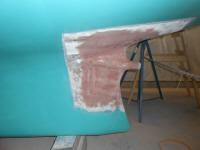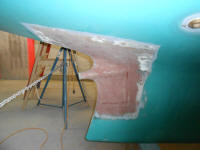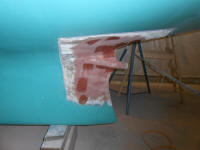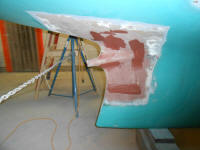
110 Cookson Lane | Whitefield, ME 04353 | 207-232-7600 | tim@lackeysailing.com
Snow Lily | Wednesday, February 13, 2013
The work on the keel and shaft extension was nearly complete, but sanding the latest round of compound revealed just a few minor low spots, which I filled as needed.
On the other side of the shaft tube, I continued work on the motor foundations. After sanding the fillets as needed, and rounding over the inboard edge of the foundation platform to ease the corner, I prepared various sections of tabbing to begin to tie the new work into the surrounding hull. Beneath the platform, I installed three double sets of biaxial tabbing to secure the various pieces. Access beneath was tight, but possible.
Over the top, I installed two layers of biaxial cloth cut to the width of the platform, and extending well onto the hull on the outboard side, then down the vertical leg and into the bilge on the inboard side. I started with two layers as I worked to build the height up to the exact level needed to support the electric motor, and anticipated the need to add additional layers later.
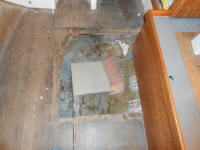
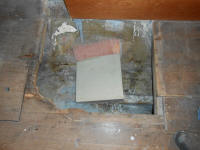
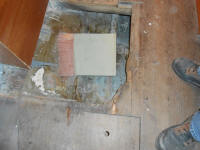
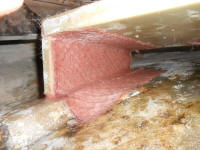
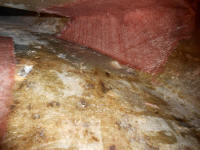

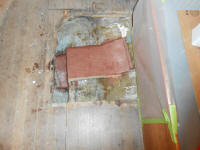
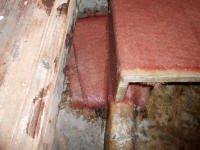
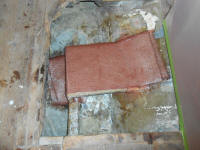
The new cushions were complete and the upholsterer arrived to test-fit them and measure for a few other small jobs aboard. The cushions, covered in graphite Ultrasuede, looked terrific, but after briefly enjoying the relatively finished aura of the cabin, I had to remove all the cushions for safekeeping during the remainder of the project.
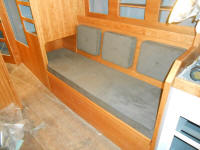
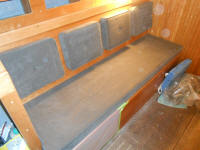
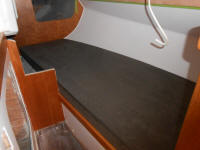

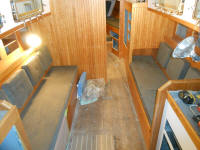
My next task was the genoa tracks. I'd collected the materials required, including eight-foot track sections and 4" long fasteners, and now geared up on the starboard side for installation. After figuring a starting point for the tracks, I began dry installation and installed several fasteners through the toerails to begin to secure the tracks and bend them into position along the curve of the toerail.
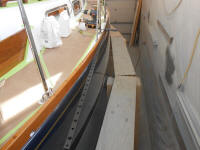

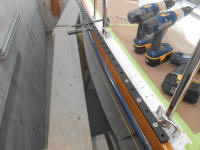
Checking inside, I was amazed to find that the 4" fasteners didn't penetrate the inside of the joint, just barely peeking through. Though I was tapping the deck for the machine screw threads, I'd intended to add large washers and nuts, so clearly I'd need longer fasteners (5"). So I placed the order for the longer bolts, and abandoned the genoa track project for the moment as there was no need to continue with the too-short fasteners, and since I wanted to return the expensive 4" bolts I didn't want to use them for a dry fit.
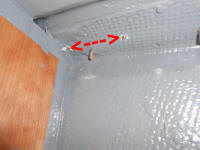
Inside the boat, I unclamped the trim piece on the head bulkhead, allowing for a better look. Once I completed the door jamb trim, I'd get to work on the final finish of the new bulkhead and associated trim.
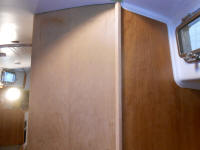
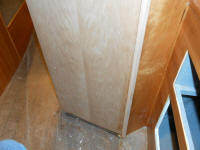
Wanting to continue with the remaining pieces of deck hardware requiring installation, I turned to the mainsheet traveler. The high beam traveler track specified to span the cockpit well came in various stock lengths, the most applicable 1.8m length being a bit overlong for the job, so to begin I determined where the track should go, measured, and cut off the track to the appropriate length (48"). With the end caps temporarily in place, I tested the track fit, planning to mark for fastener holes in the cockpit seats and overbore the holes to omit the core from and epoxy-fill in order to prepare them for final installation.
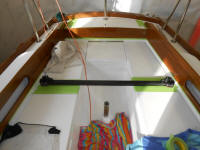
Immediately, however, I noticed a problem--not a problem, per se, but a complication that would prevent me from continuing as planned. The cockpit seats were angled downwards towards their outboard edges and the drainage gutters there, so the traveler rested only on the inside corners of the seats, not flat on their surfaces. I was aware of this on some level, I suppose, but hadn't expected it to be so drastic, even though my review of photos of the original installation had shown an old wooden support beneath the track.

I could have used wood on hand to build the wedges, but itty bitty bits of wood like this can split easily during installation, and are nightmares of maintenance; if one leaves them unfinished, they look terrible, all the more so when all the other wood is finished, and attempting to keep them in varnish is an exercise in unnecessary frustration. Instead, I sourced some black UHMW material from which I could built the wedges, which would blend in with the traveler and be maintenance free. That material would arrive on the 'morrow and I'd continue the work then.
Frustrated with my afternoon plans going so rapidly downhill, I decided to clean and varnish the cabinet doors, swashboards, and overhead trim pieces, which brought me to the end of the day.

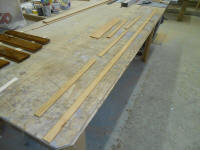
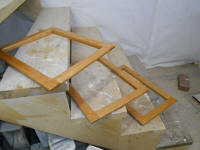
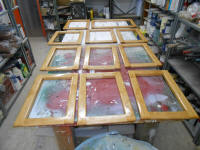
Total Time on This Job Today: 7.75 hours
